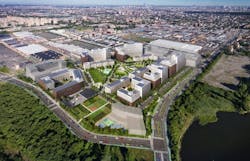$1.2B Brooklyn Affordable Housing project to be sustained by Geothermal, Solar & Waste Recovery
With above ground renewable energy systems expanding rapidly around the United States, an underground source of clean energy also is increasingly percolating within numerous commercial, industrial and residential project developments.
One of the latest and biggest is the Brooklyn Development Center Mixed-Use plan in the East New York neighborhood. Construction on the first phase of the $1.2 billion redevelopment has begun with work on hundreds of affordable housing units, an outpatient medical clinic and ground floor retail space.
The buildings in the Brooklyn project’s first phase will be designed to meet Passive House Design standards. It also will utilize a vast, closed-loop geothermal heat pump system for heating, cooling and hot water.
Rooftop solar arrays will provide some of the electricity, while a wastewater heat recovery system will contribute to the energy efficiency aspects of the project. Ultimately, the state of New York plans to create more than 2,000 homes in the area where housing disparity and unaffordability is rampant.
“We are not just building housing for the people of East New York,” NY Gov. Kathy Hochul said. “We’re investing in a community so that generations of New Yorkers can flourish and thrive. This truly transformative investment will put us on the path toward mending the societal cracks in the system to ensure all New Yorkers have a chance to prosper.”
Large-scale geothermal is on the rise throughout the U.S. Numerous universities are expanding geothermal access on their campuses.
Closed-loop geothermal circulates the fluid, or water, through a wellbore that is thousands of feet deep to radiate from the earth’s core heat. The fluid is then circulated back up while staying contained in the system.
They are expensive to dig and build, but operational costs are considered relatively efficient from that point forward.
“It’s time for the geothermal industry to take its place as an obvious part of the energy mix,” Alexander Helling, CEO of Baseload Capital, said last year. “Geothermal should be the new normal, becoming as standard to the energy mix as goretex is for outdoor clothes.”
Baseload Capital is working with Chevron New Energies, a subsidiary of the oil and gas giant Chevron, to develop geothermal projects across the country. The first project identified by the joint venture is being located in Weepah Hills in Esmeralda County, Nevada, due to strong geothermal research and advanced exploration data available.
In New York, the current largest geothermal project to support another Brooklyn development is being constructed in Coney Island. The site has more than 150 geothermal wells and should reduce emissions by 80 percent over previous energy use within developments, according to reports.
The Brooklyn Development Center project is part of the Vital Brooklyn redevelopment initiated first announced by former Gov. Andrew Cuomo in 2017.
-- -- --
(Rod Walton, senior editor for EnergyTech, is a 15-year veteran of covering the energy industry both as a newspaper and trade journalist. He can be reached at [email protected]).
Follow us on Twitter @EnergyTechNews and @rodwaltonelp and on LinkedIn.





